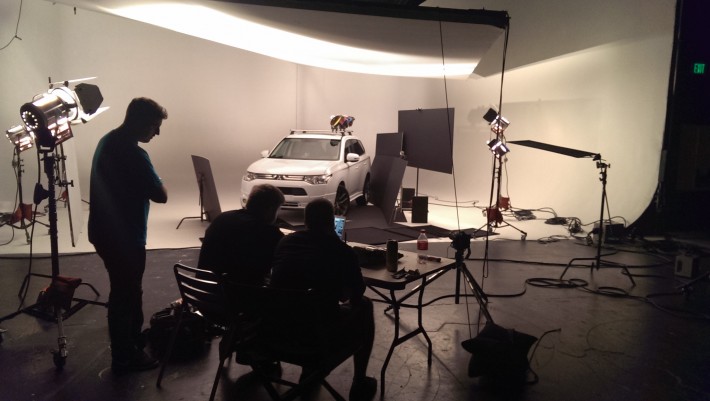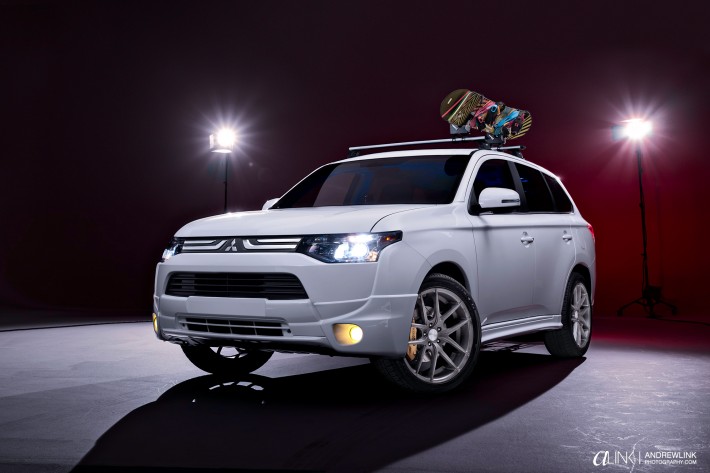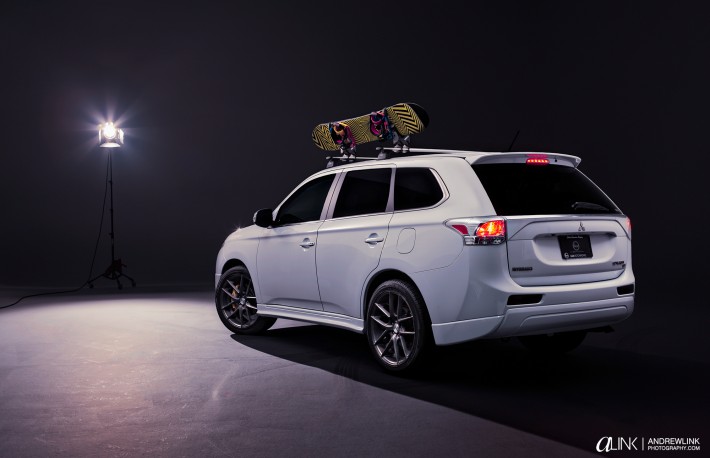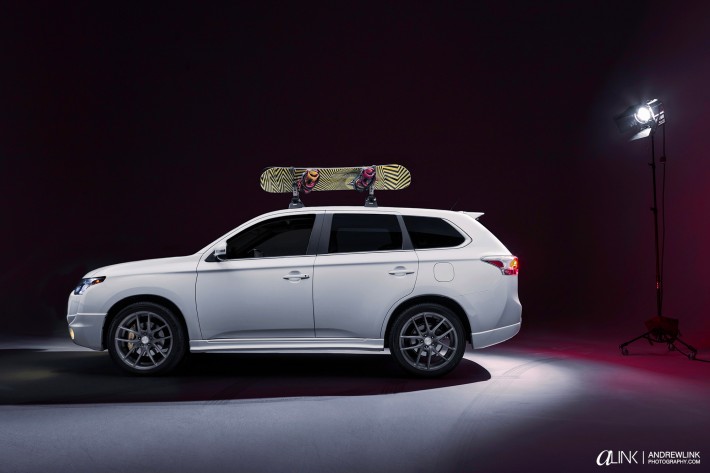A few weeks ago, I flew to Los Angeles to shoot a commercial project for Mitsubishi. They had a custom Outlander built by RIDES Magazine and were in need of press shots. Studio shooting can be among the most challenging of all types of photography, but with a little patience and some care, its really not that difficult. Here’s how we did it.
Before we start, let me say that obviously this is not the only way, or even a recommended way… more just MY way. Take this and build from it and it will result in YOUR way of lighting in the studio.
Make no mistake, shooting cars in a studio is incredibly difficult. You’re starting from absolute zero. There’s no sunlight to act as a main light while you fill in the shadows with strobe like you would on location. On top of that, the car behaves like a giant mirror, reflecting everything around it, while the white studio walls bounce light everywhere and rob your light of directionality. A successful studio shot will require you to control your reflections and use your lights to accentuate the car’s shape.
Planning
Making a studio shoot work involves some planning. My planning started by locking down a studio near where the car was stored. Luckily, the car was close to Thunder Studios in Long Beach, CA. Thunder Studios is one of my favorite car studios, due to their extensive selection of rental gear and number of stages. They have a studio size to accommodate just about anything. Securing two awesome assistants to help out on the shoot was my next on my list. For this project I called two good friends who are also amazing photographers, Richard Thompson and Nate Hassler. Having a few extra hands (and eyes) around, definitely makes a shoot run smoother. From moving lights around to consulting on angles, assistants are a tremendous help in the studio.
You’ll also want to create a shot list, if one isn’t given to you by the client. Knowing what specific shots you need beforehand will help you budget your time. Especially since studios charge some pretty hefty overtime fees if you run late. Our shot list included a front 3/4 angle, profile, and rear 3/4 angle as well as all of the custom details that had been added to this Outlander. Giving thought to the overall look you’re going for will also help you with your time. I knew from the start I wanted a raw studio look with some lights, cables, and tire tracks left in. I felt this would give the photos some character instead of just floating on white.
Lighting
Once you’ve arrived to the studio on the shoot day, it’s time to start lighting. I almost always prefer direct lighting on cars, especially in my location work. However, in the studio, I’ll use bounced light off of a flying flat if there is one. A flying flat is exactly what it sounds like, a large white panel suspended from the ceiling that you can move and angle around the car to reflect light. In the case of this Mitsubishi shoot, we used bounced light. Bounced light provides a softer quality of light that helped us really sculpt the shape of the car.
We used some old school Mole-Richardson 2K and 1K hot lights, which I always get a kick out of because they’re so retro. We placed two to the driver side of the car bounced up into the flying flat and another off the front end also bounced into the flat to light the nose of the car.
One last note on the light setup, the lights in the rear that are flaring the camera can be controlled by your cameras aperture. The smaller the aperture, the more pronounced the star shape will be.
Here’s a lighting diagram of the setup for the front 3/4 shot, (lets pretend the little guy in the center is the car).
Reflections
If you’ve been hired to shoot in a studio, chances are you know how to light. Controlling reflections will be the biggest challenge you’ll face. On location, circular polarizers are the best choice for reducing and removing reflections. However, in the studio, circular polarizers will not work as well as they do on location. You can sit there and rotate them all day and it won’t give you as good a result as it will outside, believe me…I’ve tried. In the studio there’s a better way, and it’s easier than you think.
My favorite method for controlling reflections, a method that’s left assistants to stand and stare at me with puzzled expressions almost every time I do it, is to completely line the floor around the car with black foamcore, black fabric, black flags, or honestly anything we can find that’s black. You’re simply removing anything that the car and its shiny metal body can reflect and it works EVERY TIME.
Pay close attention to the side of the car and the bumper underneath the driver side headlight in the two photos above. They were taken right after each other and the camera settings didn’t change. You can clearly see how the car reflecting the black boards sculpts out the shape of the body, while in the frame without the boards, the car reflects the white room and the shape gets lost.
Retouching
For the purists, there used to be a time where studio shots like this were completed in one shot, however, now it’s far more common to construct the final image out of a few different frames. For example this shot is made out of about 6 different frames. The background and shadow are from one base frame, and the car body, headlight, grille, wheels, and fog lights are from different exposures to ensure that each part is represented as well as possible.
That’s it, enough to get you through a studio situation should you ever find yourself in one. Remember, the best part about shooting in a studio is a chance to play around, experiment, and really create something.
I could blog day and night about shooting cars and there would still be questions left unanswered. That’s why I love to stay available. I’m always reachable, whether it be through the comments here or through my Facebook page. Drop me a line on Facebook if you have any questions at all, or even just to talk cars! I get back to everyone!








Thanks for the write up! I’m just starting out so I’m not doing studio shoots yet but this will help me if I ever do!